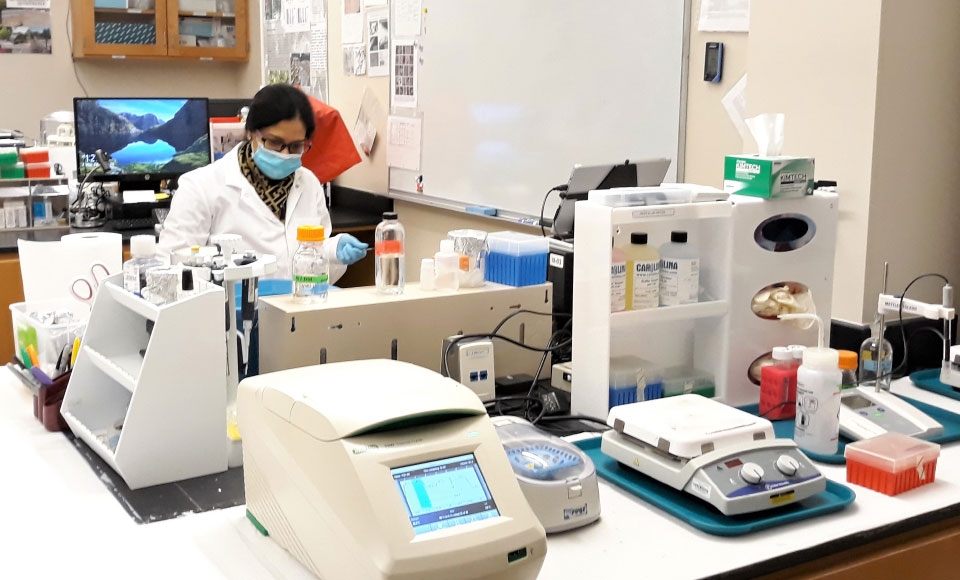Breadcrumbs
- News
- News Archive
- NORS-DUC Research Connecting Sudden Oak Death To Drought Conditions

Research underway at Dominican University of California is examining how Sudden Oak Death (SOD) could adapt to drier and warmer conditions and spread to new environments, eventually threatening more species of native plants along the California coast.
Early indicators and field monitoring show that the disease might become established among many of the more than 100 different species in the Manzanitas (genus Arctostaphylos) family.
SOD is a serious disease of native plants caused by the invasive pathogen Phytophthora ramorum. Since it was first detected in the 1990s, the disease spread along the California coast and killed many millions of trees, especially Coast Live Oaks and Tanoaks, changed whole ecosystems and increased the risk of wildfires.
P. ramorum prefers moist conditions and moderate temperatures and consequently is found mainly in the ‘fog belt’ along the Pacific Coast. However, Dr. Wolfgang Schweigkofler, research associate professor at Dominican, fears that as the region heads toward a drought, the disease is adapting to more severe conditions.
“In recent years, an increasing number of symptomatic plants were detected in warmer and drier areas, indicating that the pathogen might adapt to these conditions and threaten native plants common in those areas,” Schweigkofler says.
Read Past Coverage About Dominican's Work Focused On Controlling The Spread of Sudden Oakland Death in the San Francisco Chronicle and Santa Rosa Press Democrat.
Threatened plants include Manzanitas (genus Arctostaphylos), an important group of wooden shrubs growing mainly in the chaparral, an ecosystem characterized by the absence of trees and a Mediterranean climate. Most of the approximately 100 different species and subspecies of Arctostaphylos are endemic to California, many are rare and already endangered.
Following a 2020 “SOD Blitz” coordinated by the Garbelotto lab at UC Berkeley and hosted in Marin County at Dominican, P. ramorum was detected on several manzanita species showing severe symptoms of the disease. Schweigkofler, a former member of the Garbelotto lab, frequently collaborates with his Berkeley colleagues on studies.
In order to gain better insight into the P. ramorum-Arctostaphylos pathosystem, Schweigkofler and Dominican graduate student Bharati Gaonker inoculated several manzanita species in both a field experiment and in the lab growth chamber at Dominican. They studied symptom development, sporulation, and transmission rates to test whether or not the pathogen adapted to a new host plant and unfavorable climatic conditions.
“Whereas the plants in the field did not develop symptoms, all plants became infected by P. ramorum in the growth chamber at constant temperature and high humidity,” Schweigkofler says.
“No sporulation was detected on the symptomatic manzanita plants, therefore we don’t know yet if they can spread the disease in their environment. Although there are still many open questions, we conclude that P. ramorum has the potential to become a threat to the chaparral biodiversity.”
Schweigkofler is the lead scientist at the National Ornamentals Research Site at Dominican (NORS-DUC), a 12-year-old collaboration between Dominican, the United States Department of Agriculture (USDA), and the California Department of Food and Agriculture (CDFA).
Scientists from Dominican and other institutions are conducting studies at the NORS-DUC research site on both emerging and invasive quarantine pathogens of ornamental and native plants in an open, nursery-like environment.
Schweigkofler and his students will continue the monitoring of symptoms on manzanitas growing on chaparrals in Marin County. He also is planning to do some more inoculation studies with both ornamental (nursery) and native plants in collaboration with the USDA.
Photo above of NORS-DUC graduate student Bharati Gaonker